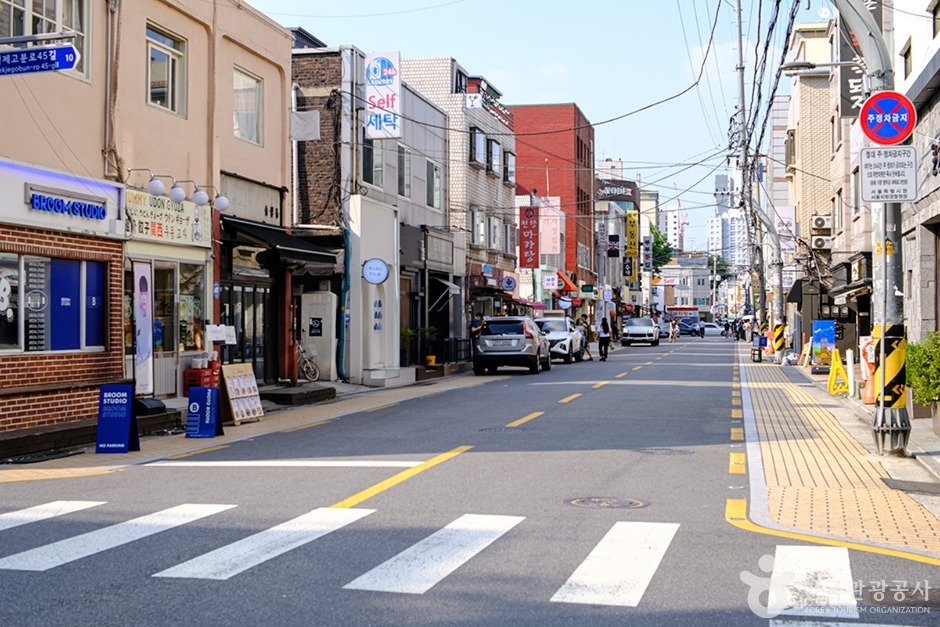Cheonho Park (천호공원)
12.8Km 2020-03-18
702, Olympic-ro, Gangdong-gu, Seoul
+82-2-489-2776
Located in Cheonho-dong, Cheonho Park is comprised of a musical fountain, an outdoor stage, and various sports facilities, making it the perfect spot for rest and leisure.
Songnidan-gil Street (송리단길)
12.8Km 2025-01-23
Baekjegobun-ro 43-gil, Songpa-gu, Seoul, and surrounding areas
Located south of the eastern side of Seokchon Lake, this street is home to numerous restaurants and cafes. Its name comes from the combination of Songpa-dong and Gyeongnidan-gil Street in Itaewon, Seoul, meaning the “Gyeongnidan-gil Street of Songpa-dong.” This street began as an otherwise unremarkable street that faced the eastern side of Seokchon Lake. Today’s “Songnidan-gil Street” came to be as cafes moved into the neighborhood, followed by restaurants and photography studios. Songnidan-gil Street is a popular hangout for young Seoulites in the southeastern side of Seoul, so on weekends, one can often find them conversing in cafes, going for drinks in bars, or waiting in line for the hottest restaurants in the neighborhood.
Amsa-dong Prehistoric Site Museum (암사동선사유적박물관)
12.9Km 2023-12-22
875 Olympic-ro, Gangdong-gu, Seoul
The archaeological sites in Amsa-dong, Seoul, were a collective settlement where people lived during the Neolithic Age about 6,000 years ago and became known to the world after the sand dunes along the Hangang River caved in during the great flood of 1925, exposing numerous pieces of comb-patterned pottery. The area designated as a historic site in 1979, and excavation of the site took place from 1981 to 1988. The cultural heritage protection area was expanded to a total area of 78,133㎡. Currently, nine Neolithic dugout huts and one experiential dugout hut have been restored. The exhibitions currently open to the public are Exhibition Hall 1, which displays a restoration of a Neolithic Age dugout, and Exhibition Hall 2, which displays various panels and models to help understand the prehistoric era as a whole.
Eoyang (어양)
12.9Km 2021-03-29
14, Wiryeseong-daero, Songpa-gu, Seoul
+82-2-422-8886
The kitchen staff trained in a famous Chinese hotel restaurant serve the best Chinese cuisine. The best menu at this restaurant is sizzling rice soup with seafood. This Chinese (cuisine) restaurant is located in Songpa-gu, Seoul.
E-Mart - Cheonho Branch [Tax Refund Shop] (이마트 천호)
12.9Km 2024-04-22
1017, Cheonho-daero, Gangdong-gu, Seoul
-
Seoul Seokchon-dong Ancient Tombs (서울 석촌동 고분군)
12.9Km 2021-02-26
21, Garak-ro 7-gil, Songpa-gu, Seoul
+82-2-421-0970
The Ancient Tombs in Seokchon-dong were found and investigated as part of the city development project in Jamsil district. It was impossible to determine the full scale of the ancient tombs in this area due to the severity of destruction. The largest tomb, the third tomb, measures 49.6 meters from east to west, 43.7 meters from south to north, and 4 meters in x_height. The tomb features three layers of stones topped by a smooth mound, which is a tomb style originating from the Goguryeo dynasty (37 BC-AD 668). The tombs are presumed to belong to one of the earliest leaders of the Baekje dynasty (18 BC-AD 660), which was founded by the people of Goguryeo who had come down southwards to establish a new kingdom around the Hangang River basin.
The square-shaped fourth tomb features a structure similar to the third tomb. Many pieces of earthenware from the early Baekje era were found in the fourth tomb. Also excavated around this site was a gold spangle earring. The third and fourth tombs have been registered as Historic Site No. 243. The tomb site offers valuable information concerning the culture and customs of the Baekje dynasty in its golden age around the 4th century, as well as the relations between the three ancient kingdoms (Goguryeo, Baekje, and Silla) around that time.


![KL [Tax Refund Shop] (Kl)](http://tong.visitkorea.or.kr/cms/resource/64/2878864_image2_1.jpg)
![Alto [Tax Refund Shop] (알토)](http://tong.visitkorea.or.kr/cms/resource/65/2878865_image2_1.jpg)
![Valleygirl [Tax Refund Shop] (벨리걸)](http://tong.visitkorea.or.kr/cms/resource/20/3314320_image2_1.jpg)

![Younggi Mind [Tax Refund Shop] (영지생각)](http://tong.visitkorea.or.kr/cms/resource/48/3314048_image2_1.jpg)

 English
English
 한국어
한국어 日本語
日本語 中文(简体)
中文(简体) Deutsch
Deutsch Français
Français Español
Español Русский
Русский